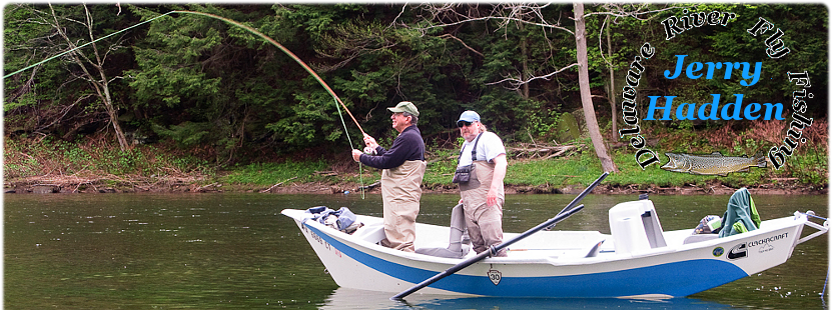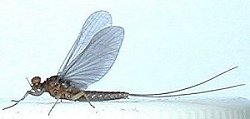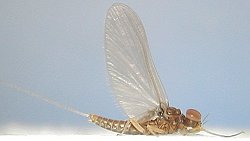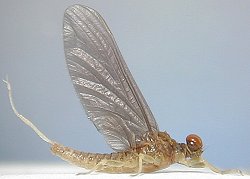
The Bugs They Are A-Changin'
Confused yet, OK so am I. After years of calling a Cloeon (The tiny blue winged olives size 22, 24, 26.), a Cloeon all of a sudden their not.
In the past entomologists classified Mayflies by comparing them physically. For instance Cloeon had only one marginal vein in it's wing while Pseudocloeon had two. Notice I say had, why? Because Cloeon and Pseudocloeon are no more. Pseudocloeon carolina (The most important Pseudocloeon on the Upper Delaware River system) is now synonymous with Acentrella turbida. (The dictionary physically synonym as, a scientific name as of a genus or species, superseded or discarded through prior use or because of incorrect application.) Now entomologists are using DNA to determine the classification of Mayflies, so they're discovering new relationships between insects.
Before I got much farther the question on your mind is, so why does all this matter to me? Well for the casual fly fisher it probably doesn't, but then consider a size 16 blue winged olive. This could mean three much different Mayflies with much different characteristics. Drunella cornuta, Attenella attenuata, or Drunella cornutella. Drunella cornuta nymphs prefer medium to fast moving riffles where the substrate consists of gravel and rocks. Hatches occur in the morning between 8:30 AM and noon, but on cooler rainy days may be found on the water into the afternoon along with Drunella cornutella. Attenella attenuata nymphs also prefer medium to fast moving riffles where the substrate consists of gravel and rocks. Unlike Drunella cornuta shed their husk on the bottom, and swim to the surface requiring a much different emerger pattern. Drunella cornutella hatch afternoon and evenings, and are much darker in color than both Drunella cornuta, and Attenella attenuata. Note that on cooler rainy days all three may be present on the water at the same time. Since all three are very similar, but have different physical characteristics, and hatching habits, it's useful to know exactly what blue winged olive we're talking about.
With all that out of the way lets look at the changes.
Baetis tricaudatus (Blue Winged Olive)

Male Baetis tricaudatus
Baetis vagans was reclassified as Baetis tricaudatus way back in 1979. It's taken the fly fishing community (including myself) this long to catch up.
Acentrella turbida (Blue Winged Olive)

Male Acentrella turbida
Pseudocloeon carolina now Acentrella turbida.
Timpanoga simplex (Blue Winged Olive)

Male Timpanoga simplex
Was Dannella simplex now Timpanoga simplex.
Stenonema vicaruim (March Brown - Gray Fox)

Male Stenonema vicaruim
No more Stenonema fuscum (Gray Fox). Stenonema fuscum (Gray Fox) is now considered to be the same as Stenonema vicaruim (March Brown). This makes perfect sense to me, for years I've been puzzled by these insects a March Brown looked identical to a Gray Fox except for size and a slight color difference. Hey now with new DNA testing I don't have to worry about it anymore, they have been found to be exactly the same insect except for a difference in color.
Drunella cornutella (Blue Winged Olive)

Male Drunella cornutella
Ephemerella cornuta, and Ephemerella cornutella have been reclassified as Drunella cornuta, and Drunella cornutella.
Attenella attenuata (Blue Winged Olive)

Female Attenella attenuata
Ephemerella attenuata is now Attenella attenuata.
Stenacron canadense (Light Cahill)

Female
Stenacron canadense
Stenonema canadense is now Stenacron interpunctatum (inter punk tate um) canadense, Stenacron canadense for short.
Stenacron heterotarsale (Cahill)

Female Stenacron heterotarsale
Stenonema heterotarsale is now Stenacron interpunctatum (inter punk tate um) heterotarsale, Stenacron heterotarsale for short.
Isonychia bicolor (Slate Drake - White Gloved Howdy)

Female Isonychia bicolor
Isonychia sadleri (Slate Drake) has been reclassified as Isonychia bicolor (White Gloved Howdy - Slate Drake). Dropping Isonychia sadleri, and leaving only Isonychia bicolor. Once again this makes sense. The difference between Isonychia bicolor, and Isonychia sadleri being Isonychia bicolor has white colored forelegs and Isonychia sadleri doesn't, or should I say didn't.
Serratella deficiens (Blue Winged Olive)

Female Serratella deficiens
Ephemerella deficiens has now been renamed to Serratella deficiens.
Leucrocuta hebe (Sulphur)

Female Leucrocuta hebe
Heptagenia hebe are now reclassified as Leucrocuta hebe.
I'm sure that there have been more changes made, and there are probably more to come, but for this article I've only listed the changes to the important insects of the Upper Delaware River System.


